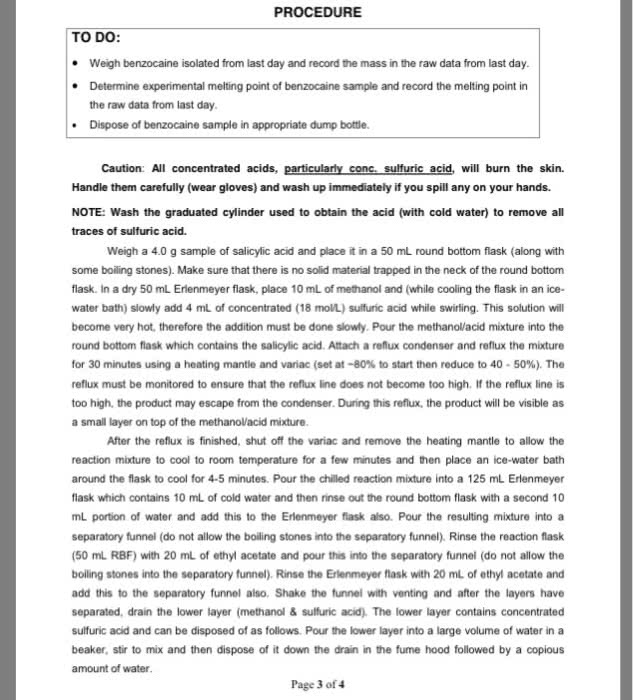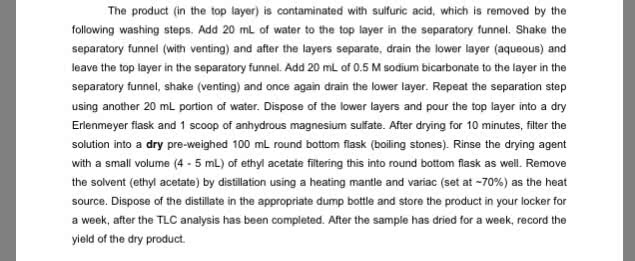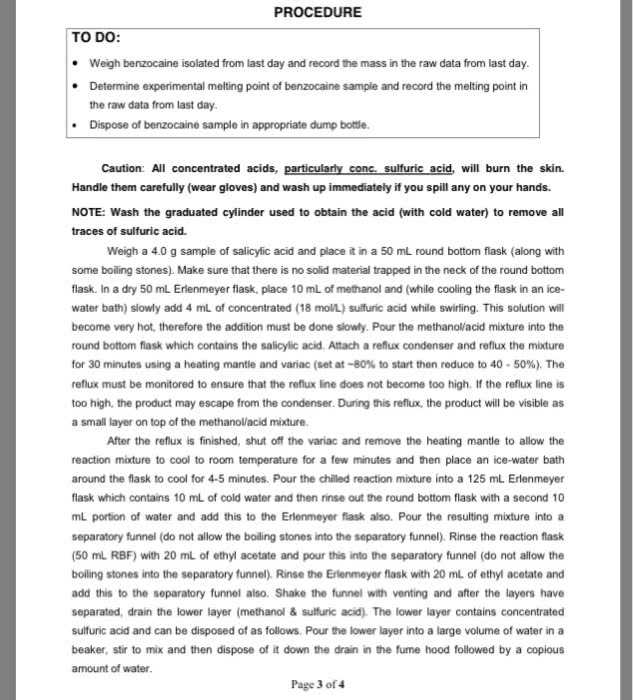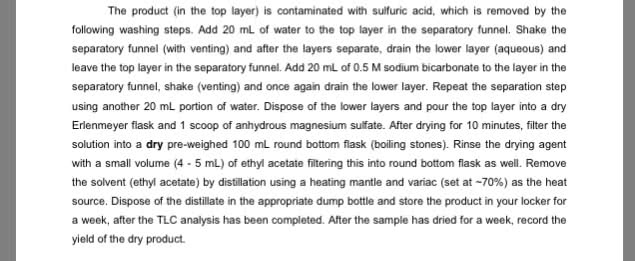Experiment: Extraction to seperate benzoic acid and naphthalene.
Procedure-
Place 2 g of a 1:1 (by weight) mixture of benzoic acid and naphthalene in a small beaker; record the exact mass of the mixture in your notebook. Add 35 mL of dichloromethane to the beaker and stir until the solid mixture has completely dissolved. Carefully pour the solution into a separatory funnel.
Add 20 mL of 3.0 M NaOH to the separatory funnel, stopper it, and shake the mixture with frequent venting. When the layers have separated, drain the bottom portion into a clean flask. Pour the aqueous layer into another clean flask labeled âaqueous layer.â Pour the organic layer back into the separatory funnel and extract with a second portion of 3.0 M NaOH. Drain the bottom layer into a clean flask labeled âorganic layerâ and pour the aqueous layer into the âaqueous layerâ flask.
Put the organic layer back into the separatory funnel and shake with 20 mL of saturated NaCl solution. Drain the organic layer into a clean, dry flask and add a small amount of anhydrous calcium chloride to dry the solution. Allow this solution to stand for at least ten minutes, with occasional swirling, then remove the drying agent by gravity filtration; place the filtrate in a round-bottom flask and remove the solvent by simple distillation or by using the rotovap. Once the dichloromethane has been removed, scrape the crystals out of the round-bottom flask into a clean, labeled, tared vial, and determine the weight and melting point of the naphthalene crystals.
Acidify the combined aqueous layers with 6.0 M HCl until the solution tests acidic to litmus paper. A white precipitate of benzoic acid should develop as the solution is neutralized. Chill the solution in an ice bath for at least ten minutes to finish precipitating the solids, then collect the benzoic acid by vacuum filtration. Wash the crystals with a small amount of cold water; then scrape the crystals into a clean, labeled, tared vial and allow to dry. Once the crystals are dry, determine their weight and melting point.
Post-Lab Question:
Write a balanced equation (using structures) for the reaction that takes place when the aqueous layer is acidified with HCl. Why does the precipitate form when the solution is neutralized? (HINT: benzoic acid (slightly soluble in water) and sodium benzoate (soluble in water)
Experiment: Extraction to seperate benzoic acid and naphthalene.
Procedure-
Place 2 g of a 1:1 (by weight) mixture of benzoic acid and naphthalene in a small beaker; record the exact mass of the mixture in your notebook. Add 35 mL of dichloromethane to the beaker and stir until the solid mixture has completely dissolved. Carefully pour the solution into a separatory funnel.
Add 20 mL of 3.0 M NaOH to the separatory funnel, stopper it, and shake the mixture with frequent venting. When the layers have separated, drain the bottom portion into a clean flask. Pour the aqueous layer into another clean flask labeled âaqueous layer.â Pour the organic layer back into the separatory funnel and extract with a second portion of 3.0 M NaOH. Drain the bottom layer into a clean flask labeled âorganic layerâ and pour the aqueous layer into the âaqueous layerâ flask.
Put the organic layer back into the separatory funnel and shake with 20 mL of saturated NaCl solution. Drain the organic layer into a clean, dry flask and add a small amount of anhydrous calcium chloride to dry the solution. Allow this solution to stand for at least ten minutes, with occasional swirling, then remove the drying agent by gravity filtration; place the filtrate in a round-bottom flask and remove the solvent by simple distillation or by using the rotovap. Once the dichloromethane has been removed, scrape the crystals out of the round-bottom flask into a clean, labeled, tared vial, and determine the weight and melting point of the naphthalene crystals.
Acidify the combined aqueous layers with 6.0 M HCl until the solution tests acidic to litmus paper. A white precipitate of benzoic acid should develop as the solution is neutralized. Chill the solution in an ice bath for at least ten minutes to finish precipitating the solids, then collect the benzoic acid by vacuum filtration. Wash the crystals with a small amount of cold water; then scrape the crystals into a clean, labeled, tared vial and allow to dry. Once the crystals are dry, determine their weight and melting point.
Post-Lab Question:
Write a balanced equation (using structures) for the reaction that takes place when the aqueous layer is acidified with HCl. Why does the precipitate form when the solution is neutralized? (HINT: benzoic acid (slightly soluble in water) and sodium benzoate (soluble in water)






